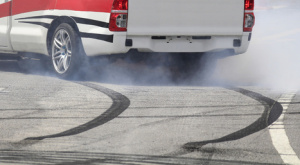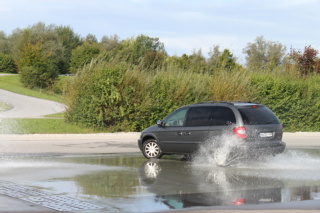Tyres are a safety-relevant component of all vehicles. But a sufficient tyre safety is only guaranteed when the tyre is in good condition. A worn profile increases the risk of aquaplaning and extends the braking distance. When buying new tyres you should keep this is mind for the purchase decision. Reviews will help you finding the best tyres in terms of safety. In order to prevent tyre damage, you should store the tyres correctly and check them before assembling. After a blowout repairing the tyre is usually possible, but still annoying - especially if the defect could have been avoided.
Here you can find some safety driving tips:

© toa555 FOTOLIA |
The stopping distance is a safety criterion which you already have been faced in driving school - at least theoretically as the calculation of the braking distance is a common exam question. Do you know the formula yet?
The braking distance is the way a vehicle covers between the start of braking and the complete standstill, whereas the stopping distance includes the thinking distance as well, which is appropriately one foot for every mph you are travelling at. For calculating the stopping distance in feet, simply use this formula: (speed) ² ÷ 20 + thinking distance. Multiply the result by 0.3 for stopping distance formula in metres. That is the theory, because in practice the stopping distance may be longer, because it depends on various factors. In addition to wet, snowy or icy roads the condition of the tyres also influences it.
This is not just about a worn treat, but also about the type of tyre. If you're travelling in the summer with winter tyres, the braking distance is suffering. The stopping distance with summer tyres vs. winter tyres is better in the warm season. This is due to the harder rubber mixture of the summer tyre.
Pay attention to your own safety and that of other motorists - always travel with the necessary distance to allow sufficient stopping distance in case of emergency.

© introducer FOTOLIA |
Aquaplaning or hydroplaning is a nightmare for many motorists. Losing control of the vehicle increases the danger of accidents. No one wants to risk it! But what is aquaplaning and how can it happen?
Conventional tyres have a tread consisting of many longitudinal and transverse grooves. On wet roads they collect the water that is laterally transported away from the tyre so that the direct contact between the tread and the road is always guaranteed. If this is not working, a film of water let the tyre float. Now the forces can not be transferred to the street. Aquaplaning makes itself felt by various symptoms:
There is a simple rule for aquaplaning: Do not brake! Use the clutch and steer straight on. The tyres should be aligned to the driving direction.
It is best, of course, if it does not even come to aquaplaning. Therefore, you should drive carefully in the rain. Also check the tread depth of your tyres regularly. Only with a tread depth of at least 3 mm a tyre provides safety. If the grooves in the in tyres are worn, however, they can not absorb enough water and so you will always drive with the risk of aquaplaning in rainy weather. Incidentally, motorists are still more afraid of aquaplaning in winter, because on slush there is a danger of slipping as well. In this case, however, there are the same rules and precautions as on wet roads.